I originally wrote this in the summer of 2002, when I was applying for a job as level designer for Massive Entertainment. I had submitted an experimental single player map for Massive's previous strategy title, Ground Control, as a work sample. Now that I was waiting for a decision from Massive , I took the opportunity to write down my most important thoughts about level design for strategy games.
In the text I talk about ”Massive RTS 2003”. I didn’t know back then that the game developed was Ground Control 2, or that it wouldn’t be released until 2004. On the other hand, I did know that the player would get to use a kind of resource, ”Aquisition points”, to buy new units for an ongoing game. This would place ”Massive RTS 2003” somwhere between traditional real time strategy games, where resource collecting and base buildning are important parts of the game, and the first Ground Control game, where you choose the units you bring for the mission and then have to do without reinforcements.
The gaming experience consists of a number of identifyable feelings, no matter what kind of game you play. Most of them are about competence, knowledge, power, control and such. To be a little more specific, I’d like to list them like this:
It is possible to delve deep into any of these points, and now I haven’t even mentioned the feelings of excitement and even fear. In this article I will just focus on the first two points, the ones about learning, especially for strategy games, and even more so on things that may be of use for the design of the game that I (in tha lack of a better name) call Massive RTS 2003.
To keep this article short, I simply state that I have the rock hard belief that learning the game is an important part of the whole gaming experience. It is pleasant to play a game where you constantly have the feeling of gaining a moderate amount of knowledge. If you are showered with demands and the need to learn, you will feel insufficient and get frustrated. If the learning pace is to low, the game gets boring. There may be other qualities that make up for it, but it is still important.
Consequently, one of the challenges for a level designer is to create a smoothe and nice learning pace that lasts through a long time of playing the game. This can be troublesome as the player may need to have a lot of knowledge before being able to do anything at all. Also, the learning may halt if the player finds a superior strategy that efficiently solves all kinds of problems. This is the infamous Red Alert tank rush.
Simply put, if the learning threshold is low, the chances are high that the player will stay with the game for a start, and if it is still possible to learn something after fifty hours of single- or multiplayer gaming, the game may become known as a classic.
Learning can be about anything the player can do that matters in the game and may include things useful even in other contexts, such as touch-typing in The Typing of the Dead and tactical or aiming skills useful in other games in the same genre.
By being aware of the different skills the player can learn or improve, the level designer can moderate the demands and challenges in the game so that the player a) learns at a steady pace, and b) gets variation in the gameplay.
For example, the player of a strategy game can receive a new kind of unit, one that has new and unique abilities. The first mission with this unit may be linear in its design and doesn’t expose the player to any time pressure, other than in the situation where he or she has decided to confront the enemy. The player can easily focus on getting accustomed to this tank or aerodyne or whatever.
I believe that every game has a gameplay mode that is the core of the game, or should be. This is where the gameplay features are of their most interesting use. The main part of the game should stick close to this core for the game’s to come to its full potential, and for the player to grow familiar to it and return to it session after session.
Still, there are advantages in leaving a regular level design. The player gets variation. Different types of level design may be used to tell different sides of the game story and to create different types of learing.
Most of all, for every mission you design, you can select the type of linearity that best accentuates whatever you want the player to learn.
As Aquisition points is included in the MRTS2003 gamplay, the game has the prerequisites to be a non-linear kind of game. The player can make decisions on a high level, so that the possible courses of events within a given level can be widely different.
Linear levels have two advantages when it comes to storytelling. First, the course of events can be directed so that important story events can be part of the in-game experience. Second, it is more grateful to include less important – but still unique – pieces of the story in a linear environment, as the player are not likely to fail in running into them.
Apart from this, as I’ve already mentioned, linear missions can be put to excellent use for the right learning curve. It is possible to isolate a single gameplay feature or an area of the gameplay for the player to learn, and for the player to get a more precise veiw of his or her own learning.
I would say that something like every fouth level should be designed in a more linear style. It should be enough to deepen the story in-game, and to keep track of the learning curve. All the while the game clearly is non-linear to its core.
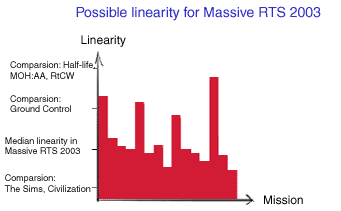
Please note that the campaign – except for the distinctively linear
missions – gets increasingly non-linear. The player’s options
stack up throughout the game. However, this development is dampened by the
player limiting his or her own freedom by excluding inefficient strategies
from consideration.
Ernest Adams and Andrew Rollings On Game Design – This book includes a thorough lecture on dominant strategies among other balancing issues.
To my Ground Control map Pieces of Hope
To my Warcraft III-map Enter Slukko
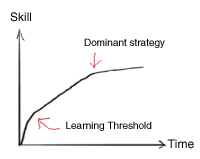
Games may lose potential players if they are difficult to get into.
It may also be that the AI-opponents are simple-minded
and the units unbalanced, making it easy for the player to find a strategy
that there is no reason do diverge from. The player loses his or her motivation
to keep playing, and the game loses a player.
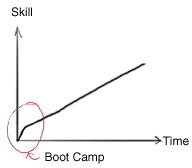
Learning in any game is ideally kept at a steady pace. Sometimes it may however be necessary that the players gets to learn some basic controls before any kind of gameplay challenge is introduced. In a 3D strategy game such as Massive RTS 2003, it may be about camera controls and some basics about how to move and attack with the troops.
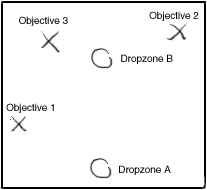
An ordinary MRTS2003 single player map could have three different enemy bases the player can attack in any order. The player can also balance an aggressive strategy against the option to catch up with reinforcements, and also select what types of units to include in the reinforcements.
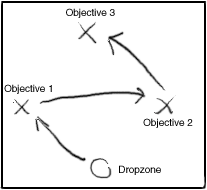
In a linear kind of level the player has to attack the enemy bases in a certain order. This means that in-game dialogues and scripted events that occure in base 3 can easily be designed to refer to things that must have taken place in base 1 and 2.
Problems in base 2 may also need weapons and equipment that the player conquers in base 1. This way new technology is efficiently introduced to the player.
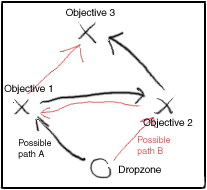
The Ground Control map Pieces of Hope illustrates a kind of level design somewhere between the distinctively linear and the distinctively non-linear. There are two easily perceivable strategies to choose from, and each of them gives some room for tactical variation.
As the level still is this linear, it can work as a concentrated lession in unit matching. The units the player is awarded with for capturing base 1 are very efficient in the attack against base 2 and the other way round. This unit matching wouldn’t have been the same in a mission including aquisition points.